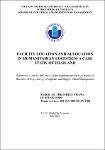| dc.description.abstract | The efficiency of humanitarian aid and the safety of affected people mainly depend on
the decisions relating to where to locate shelters and how to arrange properly the number
of beneficiaries to each chosen shelter. This study was aimed at developing a
mathematical optimization model for deciding where to establish shelters among
potential ones and how to assign impacted people into proper chosen shelters. This
model is a multi-objective one and there are three objective functions established to
enhance the performance of the disaster response. The foremost objective is to lower
the total amount of costs, which includes costs for building the shelters, costs for
transporting impacted people, and costs for paying wage of employees in each shelter.
Reducing the overall total duration for transporting the affected people from all impacted
zones to designated shelters is considered as the subsequent objective. The last one is to
diminish the quantity of places of shelter needed to provide complete assistance to
impacted people. And then the Epsilon Constraint method is used to find out results for
the suggested model. The effectiveness and feasibility of the suggested model is proven
by an instance of inundation of the largest of the southern provinces in Thailand. The
outcomes achieved by applying the suggested mathematical model is then contrasted
with the existing strategy made by the public sector of Thailand. The contrasts indicate
that the outcomes attained from applying the suggested model surpass the existing
strategy of government. Moreover, decision makers pondering how to set up the
appropriate strategy to save victims as much as possible could benefit from the outcome
of this thesis and have more insights about humanitarian aid process. | en_US |


